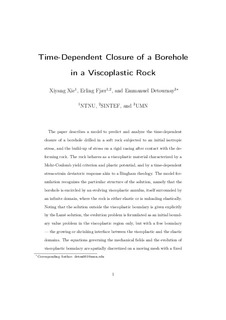| dc.contributor.author | Xie, Xiyang | |
| dc.contributor.author | Fjær, Erling | |
| dc.contributor.author | Detournay, Emmanuel | |
| dc.date.accessioned | 2020-03-17T13:57:47Z | |
| dc.date.available | 2020-03-17T13:57:47Z | |
| dc.date.created | 2019-06-13T13:00:11Z | |
| dc.date.issued | 2019 | |
| dc.identifier.citation | Geomechanics for Energy and the Environment. 2019, 19:100115 1-14. | nb_NO |
| dc.identifier.issn | 2352-3808 | |
| dc.identifier.uri | http://hdl.handle.net/11250/2647218 | |
| dc.description.abstract | The paper describes a model to predict and analyze the time-dependent closure of a borehole drilled in a soft rock subjected to an initial isotropic stress, and the build-up of stress on a rigid casing after contact with the deforming rock. The rock behaves as a viscoplastic material characterized by a Mohr–Coulomb yield criterion and plastic potential, and by a time-dependent stress–strain deviatoric response akin to a Bingham rheology. The model formulation recognizes the particular structure of the solution, namely that the borehole is encircled by an evolving viscoplastic annulus, itself surrounded by an infinite domain, where the rock is either elastic or is unloading elastically. Noting that the solution outside the viscoplastic boundary is given explicitly by the Lamé solution, the evolution problem is formulated as an initial boundary value problem in the viscoplastic region only, but with a free boundary — the growing or shrinking interface between the viscoplastic and the elastic domains. The equations governing the mechanical fields and the evolution of viscoplastic boundary are spatially discretized on a moving mesh with a fixed number of nodes. The final system of equations is a set of first order ODEs that are efficiently solved using the MATLAB routine ODE45. The numerical simulations reveal (i) the time-dependent deformation and stress state of rock in the viscoplastic annulus before and after the contact, (ii) the time of first contact between the deforming rock and the casing, (iii) the effective duration of the stress build-up on the casing, and (iv) the large time contact pressure, which is well approximated by the elastoplastic solution. | nb_NO |
| dc.language.iso | eng | nb_NO |
| dc.publisher | Elsevier | nb_NO |
| dc.rights | Attribution-NonCommercial-NoDerivatives 4.0 Internasjonal | * |
| dc.rights.uri | http://creativecommons.org/licenses/by-nc-nd/4.0/deed.no | * |
| dc.title | Time-dependent closure of a borehole in a viscoplastic rock | nb_NO |
| dc.type | Journal article | nb_NO |
| dc.type | Peer reviewed | nb_NO |
| dc.description.version | acceptedVersion | nb_NO |
| dc.source.pagenumber | 1-14 | nb_NO |
| dc.source.volume | 19:100115 | nb_NO |
| dc.source.journal | Geomechanics for Energy and the Environment | nb_NO |
| dc.identifier.doi | 10.1016/j.gete.2019.02.001 | |
| dc.identifier.cristin | 1704650 | |
| dc.relation.project | Norges forskningsråd: 244420 | nb_NO |
| dc.description.localcode | © 2019. This is the authors’ accepted and refereed manuscript to the article. Locked until 13.02.2021 due to copyright restrictions. This manuscript version is made available under the CC-BY-NC-ND 4.0 license http://creativecommons.org/licenses/by-nc-nd/4.0/ | nb_NO |
| cristin.unitcode | 194,64,90,0 | |
| cristin.unitname | Institutt for geovitenskap og petroleum | |
| cristin.ispublished | true | |
| cristin.fulltext | postprint | |
| cristin.qualitycode | 1 | |

